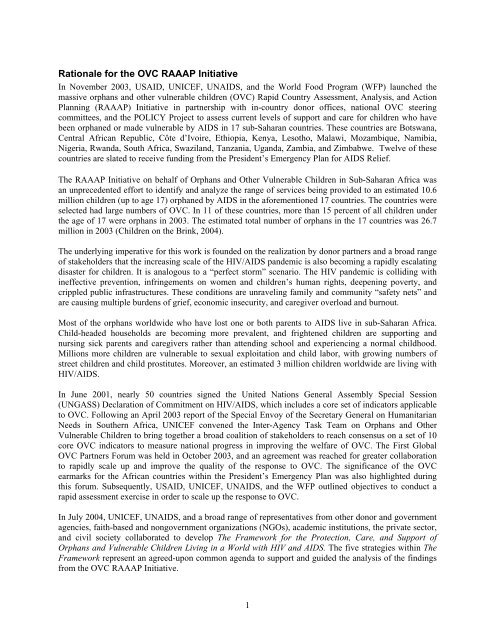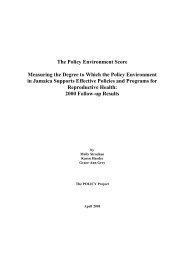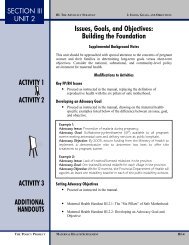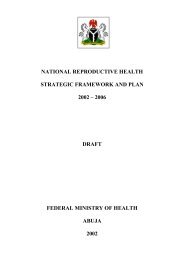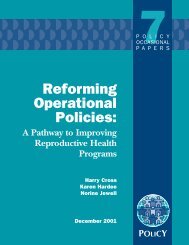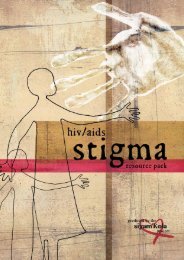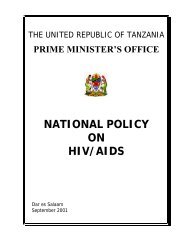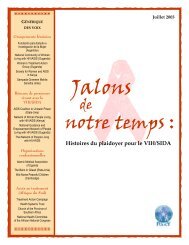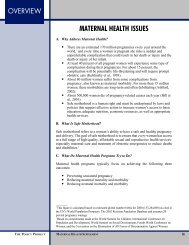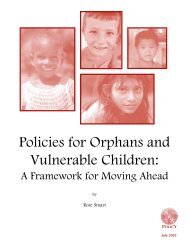THE OVC RAAAP FINAL REPORT - POLICY Project
THE OVC RAAAP FINAL REPORT - POLICY Project
THE OVC RAAAP FINAL REPORT - POLICY Project
You also want an ePaper? Increase the reach of your titles
YUMPU automatically turns print PDFs into web optimized ePapers that Google loves.
Rationale for the <strong>OVC</strong> <strong>RAAAP</strong> Initiative<br />
In November 2003, USAID, UNICEF, UNAIDS, and the World Food Program (WFP) launched the<br />
massive orphans and other vulnerable children (<strong>OVC</strong>) Rapid Country Assessment, Analysis, and Action<br />
Planning (<strong>RAAAP</strong>) Initiative in partnership with in-country donor offices, national <strong>OVC</strong> steering<br />
committees, and the <strong>POLICY</strong> <strong>Project</strong> to assess current levels of support and care for children who have<br />
been orphaned or made vulnerable by AIDS in 17 sub-Saharan countries. These countries are Botswana,<br />
Central African Republic, Côte d’Ivoire, Ethiopia, Kenya, Lesotho, Malawi, Mozambique, Namibia,<br />
Nigeria, Rwanda, South Africa, Swaziland, Tanzania, Uganda, Zambia, and Zimbabwe. Twelve of these<br />
countries are slated to receive funding from the President’s Emergency Plan for AIDS Relief.<br />
The <strong>RAAAP</strong> Initiative on behalf of Orphans and Other Vulnerable Children in Sub-Saharan Africa was<br />
an unprecedented effort to identify and analyze the range of services being provided to an estimated 10.6<br />
million children (up to age 17) orphaned by AIDS in the aforementioned 17 countries. The countries were<br />
selected had large numbers of <strong>OVC</strong>. In 11 of these countries, more than 15 percent of all children under<br />
the age of 17 were orphans in 2003. The estimated total number of orphans in the 17 countries was 26.7<br />
million in 2003 (Children on the Brink, 2004).<br />
The underlying imperative for this work is founded on the realization by donor partners and a broad range<br />
of stakeholders that the increasing scale of the HIV/AIDS pandemic is also becoming a rapidly escalating<br />
disaster for children. It is analogous to a “perfect storm” scenario. The HIV pandemic is colliding with<br />
ineffective prevention, infringements on women and children’s human rights, deepening poverty, and<br />
crippled public infrastructures. These conditions are unraveling family and community “safety nets” and<br />
are causing multiple burdens of grief, economic insecurity, and caregiver overload and burnout.<br />
Most of the orphans worldwide who have lost one or both parents to AIDS live in sub-Saharan Africa.<br />
Child-headed households are becoming more prevalent, and frightened children are supporting and<br />
nursing sick parents and caregivers rather than attending school and experiencing a normal childhood.<br />
Millions more children are vulnerable to sexual exploitation and child labor, with growing numbers of<br />
street children and child prostitutes. Moreover, an estimated 3 million children worldwide are living with<br />
HIV/AIDS.<br />
In June 2001, nearly 50 countries signed the United Nations General Assembly Special Session<br />
(UNGASS) Declaration of Commitment on HIV/AIDS, which includes a core set of indicators applicable<br />
to <strong>OVC</strong>. Following an April 2003 report of the Special Envoy of the Secretary General on Humanitarian<br />
Needs in Southern Africa, UNICEF convened the Inter-Agency Task Team on Orphans and Other<br />
Vulnerable Children to bring together a broad coalition of stakeholders to reach consensus on a set of 10<br />
core <strong>OVC</strong> indicators to measure national progress in improving the welfare of <strong>OVC</strong>. The First Global<br />
<strong>OVC</strong> Partners Forum was held in October 2003, and an agreement was reached for greater collaboration<br />
to rapidly scale up and improve the quality of the response to <strong>OVC</strong>. The significance of the <strong>OVC</strong><br />
earmarks for the African countries within the President’s Emergency Plan was also highlighted during<br />
this forum. Subsequently, USAID, UNICEF, UNAIDS, and the WFP outlined objectives to conduct a<br />
rapid assessment exercise in order to scale up the response to <strong>OVC</strong>.<br />
In July 2004, UNICEF, UNAIDS, and a broad range of representatives from other donor and government<br />
agencies, faith-based and nongovernment organizations (NGOs), academic institutions, the private sector,<br />
and civil society collaborated to develop The Framework for the Protection, Care, and Support of<br />
Orphans and Vulnerable Children Living in a World with HIV and AIDS. The five strategies within The<br />
Framework represent an agreed-upon common agenda to support and guided the analysis of the findings<br />
from the <strong>OVC</strong> <strong>RAAAP</strong> Initiative.<br />
1


